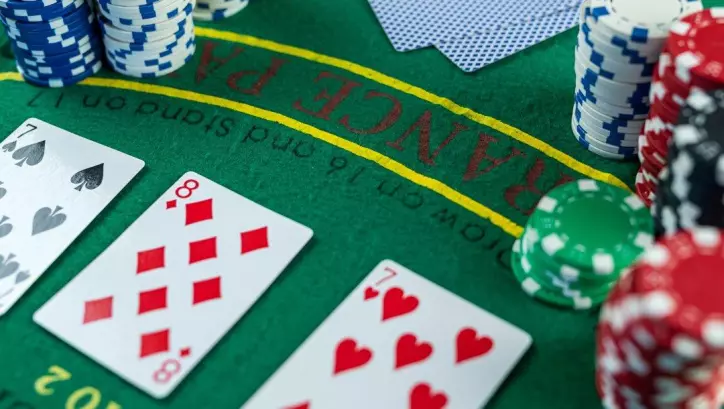Many novices, and even some more seasoned players, mistakenly assume that the terms “set” and “trips” can be used interchangeably. While both expressions refer to three-of-a-kind poker hands, there exists a noteworthy distinction between the two.
This article aims to elucidate both the semantic and strategic disparities between sets and trips in poker. Whether you’re engaged in live or online poker, this comprehension will contribute to enhancing your gameplay.
Two Varieties of Three of a Kind
Indeed, the terms “sets” and “trips” both denote poker hands with three identical cards. Nevertheless, the pivotal distinction hinges on your hole cards.
If you possess a pocket pair and the third matching card emerges from the community cards on the board, that constitutes a set.
Conversely, consider a scenario in which you have assembled three of a kind with only one of your hole cards and two cards from the community. In such a case, you are holding trips.
Illustrative Examples
Let’s delve into examples to illustrate these concepts. Suppose your hand comprises pocket 10s, and the board displays ace, jack, 10, 7, 4. In this situation, you have a pair in your hand, and the third 10 emerges from the community cards, constituting a “set of 10s.”
Alternatively, imagine your hand is king-queen, and the board reveals king, king, 10, 9, 4. Once again, you have achieved three of a kind. However, two kings are present among the community cards, with just one originating from your hand. This configuration results in “trip kings.”
Probabilities on the Flop
To attain a set on the flop, you need to commence the game with a pocket pair. The likelihood of the third card appearing among the initial three community cards is +828.
On the other hand, if you aspire to attain trips, you will require two hole cards of distinct values. The odds of forming three of a kind on the flop are notably lower at +7,307.
Sets vs. Trips: Which Holds the Advantage?
Certainly, one might assume that sets and trips are equally valuable, given that both constitute different variations of three-of-a-kind hands. However, this assumption doesn’t entirely hold.
Texas Hold’em poker hinges on concealed information. With more knowledge, you can make more informed decisions. Consequently, it’s preferable for your opponents to glean as little information as possible.
This is where the distinction between the two forms of three-of-a-kind becomes significant. Can you already discern which one is more advantageous? If not, fret not, as the following paragraph will unveil the answer.
The Stealth of Sets
Poker coaching emphasizes the art of deducing what cards your opponents might be holding. You can deduce this from various factors, including their playing style and the visible cards on the table.
In Texas Hold’em games, it’s relatively conspicuous when a potential straight or flush is on the horizon. Players become alert when the board exhibits connectivity or when the flop contains three cards of the same suit, such as spades. In both scenarios, most players raise their guard.
However, what transpires when the board presents a rainbow of cards, resembling queen, 9, 7, 4, 2? A hand like pocket 9, for instance, forms a potent yet exceedingly discreet set.
This is precisely where the strength of a set lies. Your adversaries typically won’t anticipate it, thereby increasing the pot size when they shouldn’t. Sets can be formidable hands for accumulating chips from average players and securing substantial pots.
Trips Are More Predictable

In contrast, trips unfold in a distinct manner. Consider a scenario where your hand consists of king-9, and the board reveals queen, 9, 9, 7, 3. You’re adopting a somewhat aggressive betting strategy. What conclusions might your opponent draw?
Most players, except complete novices, would likely deduce that you possess a third 9. That’s the most conspicuous inference from the given board.
Consequently, they will adjust their playing style accordingly. If they believe they can’t beat your hand, they will likely fold. While it’s indeed possible to win with trips, the pots you claim will almost invariably be smaller when compared to sets.
Furthermore, trips introduce the possibility of your opponent also having the same three of a kind. In the aforementioned example, it’s not difficult to imagine your adversary holding ace-9. In such a situation, you would lose due to their possession of a higher-ranking kicker.
Strategies for Playing Sets vs. Trips
Given that sets are stronger than trips, should they be approached differently in terms of gameplay? Absolutely.
Strategies for Playing Sets
Sets can be played with a more aggressive stance. Your adversaries won’t easily discern your hand, potentially making them more inclined to commit chips to the pot under the impression that you might be bluffing, for instance.
Nevertheless, it’s crucial, as always, to remain attentive to the board and your opponents’ tendencies. Three of a kind is a formidable hand, but it’s far from invincible. If it appears that your opponent is likely to form a flush or another higher-ranked hand, proceed cautiously to avoid unnecessary chip losses.
Strategies for Playing Trips
When you hold trips, it’s rare to catch your opponents off guard with three of a kind. This is particularly true when playing online poker tournaments, where your opponents tend to be more experienced than casual players in physical casinos, and two of the cards are face-up.
What occurs if you make a substantial chip bet in such a situation? Well, unless your opponents possess strong hands, they are likely to fold. Even if you emerge victorious, your chip gains will be relatively modest. However, there are two ways to overcome this issue.
Firstly, it’s important to maintain a balanced range, a practice you should employ consistently. Logically, you should incorporate occasional bluffs to keep your opponents guessing. If you never bluff, your opponents will have certainty about the strength of your hand whenever you raise.
Secondly, you might choose to check occasionally. Ideally, another player will hold a hand like top pair or attempt to seize the pot. You can then opt to call and allow them to continue betting, or initiate a check-raise. In either scenario, you’re building the pot.
Embark on a Winning Journey
Now that you comprehend the disparity between trips and sets in poker, these nuanced distinctions can collectively contribute to enhancing your overall win rate. Even the most marginal of advantages will accumulate over time. Naturally, it’s imperative to put this theory into practice for it to truly take root and improve your poker prowess.


